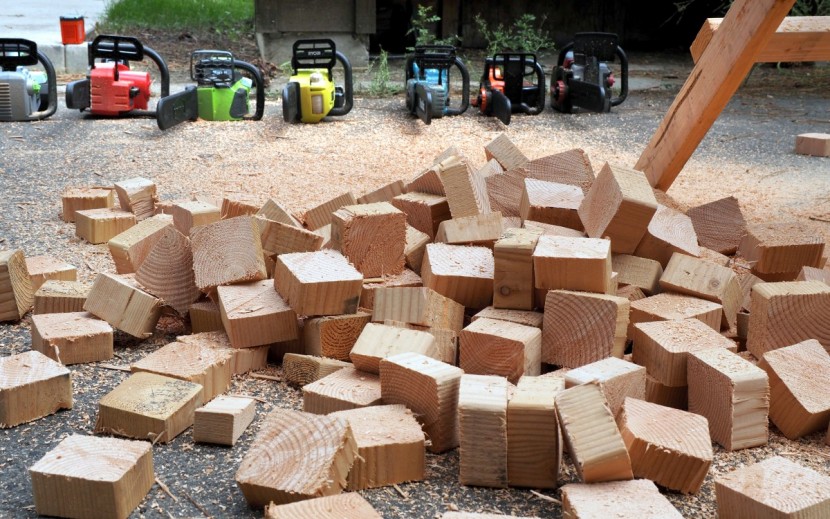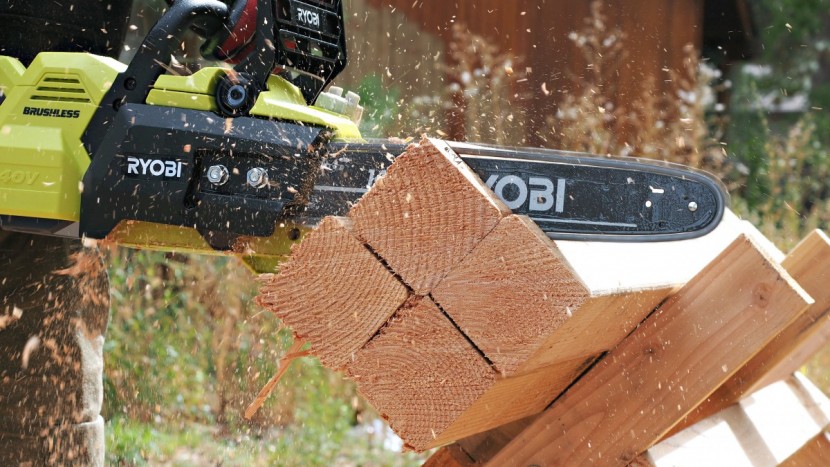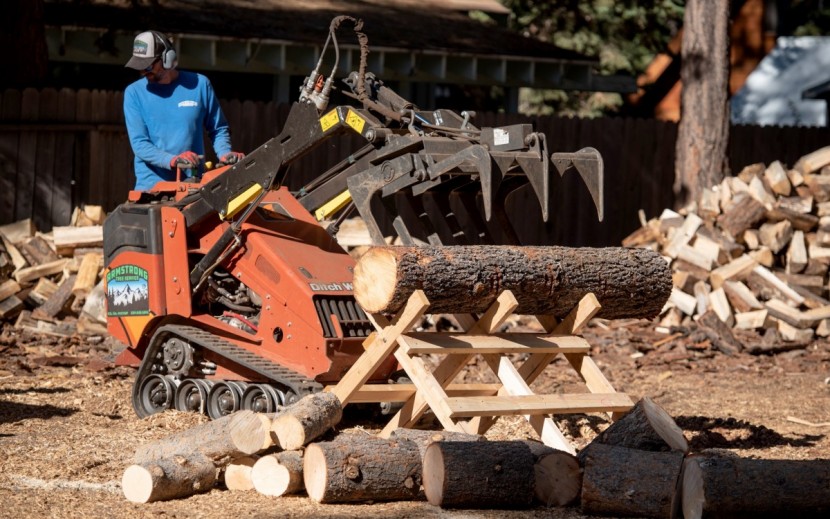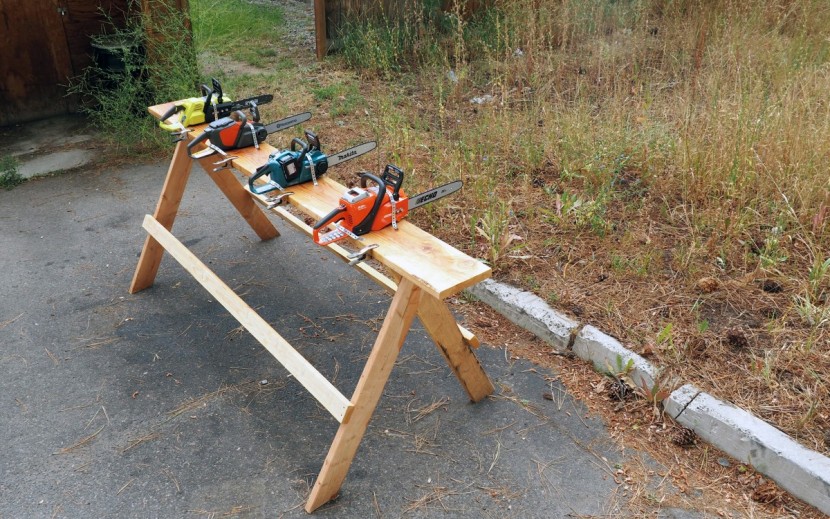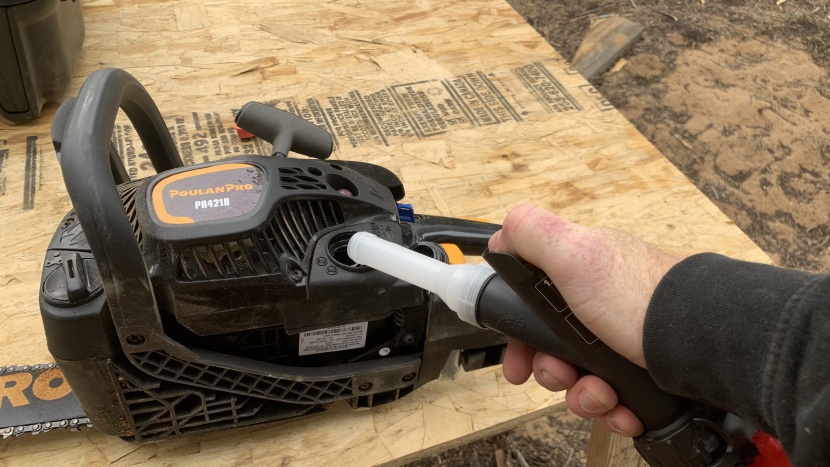If you're like us, then the idea of getting to test out a bunch of chainsaws sounds like a really good time. Before we got to slicing and dicing a stack of lumber and firewood to pieces we meticulously scrutinized online forums and customer reviews for dozens of models. Once we purchased what we deemed to be the best candidates for our review we got straight to work. We used quantitative parameters, and qualitative parameters, and cut through a mountain of wood. We narrowed our tests down to four individual metrics with a corresponding weight to their significance. Read below for a full rundown of our testing process.
Saw Performance
A chainsaw doesn't have much use if it cannot efficiently cut through wood, so we decided that performance should be the primary focus of our review. We began our analysis by creating a sawing time trial. We knew that it was important for the saws to make cuts through as close to the same type, amount, and volume of wood as possible in order to create a true side-by-side comparison. Unfortunately, this means that taking several slices off of a log wouldn't have been the appropriate experiment because trees change in diameter and density at different points along the trunk. To help normalize the volume and density of each cut we opted to purchase dried, milled lumber for the test.
Considering that the saws in our review were designed to be consumer versus commercial models, we concluded that wood with a diameter of 9" would be the perfect size for our test. Because 9" posts are not readily available, we simply translated the area of a 9" circle (63.6 square inches) to an 8"x8" beam. Rather than purchase one full-sized beam, we took it a step further and strapped four individual 4"x4" beams together in an attempt to reduce the chance of one saw taking all of its trial cuts in an area of knots or added density in a single piece. At maximum power, we measured the amount of time that it took from the moment the chain touched the top piece of wood until the moment the bottom piece of wood became airborne. We ran 5 trials per saw, threw out any outliers that may have been a result of operator error, and took an average of remaining times. During this process, we also timed how long it took the saws to go from stopped to full throttle — a measurement we call “wind-up time.”
Despite the inconsistencies of logs, we decided that we still needed to get the saws tearing into some raw rounds of wood. For our subjective cutting test, we loaded the various models up and headed to a commercial tree service wood yard and spent the day cutting up pine logs to be seasoned, split, and eventually sold as firewood. With each saw, we made cuts in logs of various diameters and states of dryness. Throughout the day we carefully noted the cutting power and overall feel of each chainsaw's operational abilities. After hours of wielding each model, it was apparent which ones were designed to slaughter logs and which ones would be better suited for pruning an ornamental tree in a backyard.
Ease of Use
Our team agreed that Ease of Use should be the metric that holds the second most amount of weight for the review. When you're spending your hard-earned money on a power tool intended to do a job that is an outright sufferfest to get done by hand, the last thing you want is for the product to be a pain to operate. This metric is much more subjective than the others so we took careful notes on a number of details ranging from the tiny to the glaringly obvious. The primary factor ruling Ease of Use was the various types of buttons, safety switches, chain brakes, triggers that each model had — and how well they worked together. We were looking for the models that were the most basic to get started while still maintaining a comfortable level of safety. After that, we removed and installed each bar and chain 5 times so we could get a good idea of how time-consuming or complicated the process can be for all of the various tensioning systems. We wanted to see which systems not only got the job done but were also intuitive to use for someone unfamiliar with chainsaws. We recognized the type of bar oil tank cap and how convenient it was to use with oily gloves on. Saws that are more balanced while holding the front handle with one hand tended to be more comfortable and effortless to lift up and set down so we assigned points as we saw fit.
In general, we assume that a lighter saw is easier to use, but for certain situations, this doesn't hold true. Sometimes the extra weight of the saw helps cutting performance, in other instances the extra load can make for some very tired arms. We weighed each battery-powered chainsaw with the battery attached in case any of the manufacturers had listed their models without them, that way you know exactly how light or heavy of a tool you'll be getting. We weighed gas-powered and corded electric models, we weighed them dry. The size of the saw may also be important for people with limited space or you may want a larger bar for bigger jobs. We carefully measured the saw bodies as well as the length of the bars to gain more quantitative data.
Power Performance
For this metric, we considered the availability and use of power for each of the three types of chainsaw — battery-powered, gas-powered, and corded electric. Because the types have glaring differences, we tested each sub-category with a different set of parameters.
Battery-Powered
The main source of skepticism in regards to electronic anything from the gas guzzler world has always been battery life. It's critical that any cordless power tool has a solid enough battery to get the job done, or at least has a quick enough recharge time to not slow you down too much. For battery-powered saws, we divided Power Performance into two experiments — one for run-time and one for charge time. With each battery charged to 100%, we carefully mounted the chainsaws to a wooden work table with the saw body on the table and the bar hanging off the edge. We then fully pinned the throttles using utility clips and recorded the run time with no load, stopping once every 20 minutes to top off the oil, until each battery died. After the run-time test, we simply slapped each battery back on its charger and patiently watched them with a stopwatch to establish the charge time. Considering that a project would come to a stop in the event of a dead battery, we adjusted scores according to charge time.
Gas-Powered
For our study, we assumed that electric models we will already have power on-site, so with gas-powered saws we assumed that we will already have gasoline on site. However, these machines require that you mix gas with 2-cycle oil to the proper ratio in a separate gas can before you can put it in your saw, so we timed this process. In a similar time trial to the battery-powered test, we anchored the saws and held the throttles at full throttle with a utility clip until they ran out of fuel. For gas-powered models we opted to stop every ten minutes to allow the machines to cool down and to top off their bar & chain oil tanks.
Corded Electric
For this type of saw, we can't run a time trial to test how long they will last because, ideally, they'd never run out of power. Instead, we subjectively judged the availability of power sources as well as the limitations and added headache of being anchored to an extension cord.
Noise
There's no way around it — all chainsaws are loud. The rotation of the chain in combination with the tearing of wood is going to make a significant amount of noise even with a relatively quiet brushless electric motor. However, they do vary from saw to saw to a good degree in both pitch and volume. To measure the volume we used a decibel meter at a distance of 4 feet. Volume, however, isn't always a good indicator of noise. To get a subjective measure of pitch, we had the saw operator take note of any whines, screams, or other noises that were notably displeasing. We assumed that many of these saws will be used in an urban setting, so to figure out how much you might be annoying your neighbors, we had a panel of judges stand at a distance of 50 feet and conclude which saws were the least and most bearable to listen to.
Conclusion
We have had a great time since diving into power tool reviews over the last five years. We believe in and stand by our testing process, our scores, and our award winners and we hope that you do too.
Looking for more great tool reviews? Check out our side-by-side analysis of other types of tools and our exhaustive reviews on a whole swath of devices from top cordless impact drivers and the best stud finders to some of the best cordless lawnmowers. If you are starting your tool collection from scratch, take a look at our list of the tools of the year to get yourself started with the greatest essentials.
